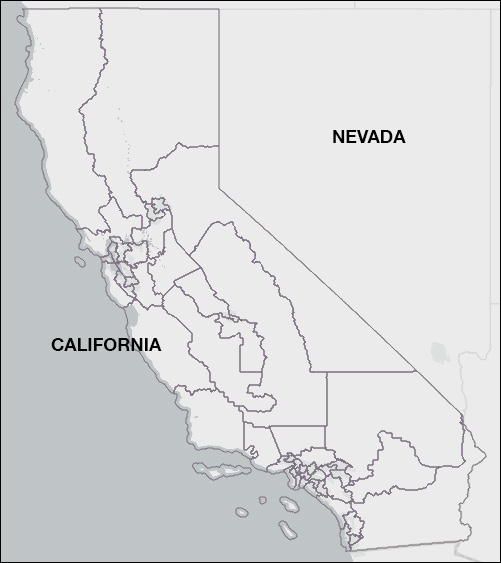
The California Citizens Redistricting Commission released its first congressional redistricting map in rudimentary form, not even including district numbers.
By Jim Ellis
Oct. 29, 2021 — The California Citizens Redistricting Commission released its first congressional map, and, while a long way from completion, the first edition gives us an idea as to where the members are headed. Though the map was released for public comment, it is rudimentary in form, not even including district numbers.
Since California loses a seat in reapportionment, the mystery of which area and political party will absorb the seat loss appears to be answered. Using raw numbers, because all 18 congressional districts that are self-contained within or partially occupy Los Angeles County need more residents, the seat loss should come there.
Such is the case with this first commission map, and it is the district that Rep. Karen Bass (D-Los Angeles) is vacating to run for mayor. Most of the current Bass district is collapsed into Rep. Maxine Waters’ (D-Los Angeles) seat under this first plan. If this were the final draw, Democrats would sustain the seat loss.
Dave Wasserman of the Cook Political Report released a partial analysis of the map, and finds that each party would benefit in an equivalent number of seats. Using the Biden-Trump ’20 numbers, the incumbents getting the worst draws appear to be Reps. Darrell Issa (R-San Diego), Devin Nunes (R-Tulare), and Josh Harder (D-Turlock/Modesto).
The Issa seat in San Diego appears to annex the Democratic city of Chula Vista before expanding all the way to Arizona through Imperial and Riverside Counties. It would move from a Trump plus-6 to a Biden plus-3 according to the Wasserman analysis. The Issa district was radically changed even though the current version required only 3,240 more people to meet the state population quota of 760,350 residents per congressional district.
Rep. Nunes’ Central Valley district would move from a Trump plus-5 seat to a Biden plus-3 but still maintain most of the congressman’s political base. Rep. Nunes’ current 22nd District is one of 18 CDs that are over-populated, the sixth highest in fact, having to shed 27,443 individuals. Clearly, most of the exiting individuals are from Republican areas.
Rep. Harder is the Democratic incumbent who gets the worst draw. His San Joaquin Valley district would move from a Biden plus-3 to a Trump plus-1, and clearly makes the seat significantly more competitive. The current Harder 10th District is close to the population quota, only having to shed 7,569 individuals.
Other members are also negatively affected. Rep. Doug LaMalfa’s (R-Oroville) 1st District, which has to gain the second-largest population segment in the state, 58,395 residents, would transform from a Trump plus-15 to a Trump plus-6 district, largely because Democratic Yolo County, which houses the University of California at Davis, appears to be added to a 1st District that would stretch all the way from the Sacramento suburbs to the Oregon border.
Rep. Ami Bera (D-Elk Grove/Sacramento) would drop to a Biden plus-4 district from his current 7th CD that yielded a 14-point win for the president. This district also has to shed population, 25,805 people in an exact count.
Rep. Mike Garcia (R-Santa Clarita), who won re-election with only a 333-vote spread, would see his 25th CD, which needs to gain only 6,606 residents, move two points more Democratic, from a Biden plus-10 to a Biden plus-12 district.
Two other members, Reps. Tom McClintock (R-Elk Grove/ Yosemite) and Raul Ruiz (D-Coachella), also would see their districts become slightly more competitive, but each should continue to win re-election with comfortable margins. Rep. McClintock’s 4th CD would slip from Trump plus-10 to Trump plus-8. Rep. Ruiz’s Riverside County anchored 36th CD would move to a greater degree, from Biden plus-14 to Biden plus-8.
Four members, including three of the most competitive Republicans, would see their districts improve in a partisan context. Rep. David Valadao (R-Hanford), who has one of the most Democratic seats in the country that elects a Republican to the House and a district that he lost in 2018 only to regain in 2020, would inherit some of the Republicans that the adjacent Rep. Nunes’ district loses. His 21st District would move from Biden plus-11 to Biden plus-9.
Similarly, Rep. Young Kim’s (R-La Habra) 39th District would also improve two percentage points in her direction, going from Biden plus-10 to Biden plus-8.
Perhaps one of the biggest Republican winners is freshman Rep. Michelle Steel (R-Orange County) in the coastal 48th CD. After gaining 40,017 new people, the district would move from a Biden plus-2 to a Trump plus-1 domain.
Finally, and staying in Orange County the most over-populated district in the state would also become more Democratic. Rep. Katie Porter’s (D-Irvine) 45th District needs to shed 53,645 individuals and would move from Biden plus-11 to Biden plus-15.
Overall, under this first proposal, the Democrats lose the reapportionment seat, with three Republican seats and two Democratic becoming competitive to the degree that the current incumbents could find themselves battling through a toss-up contest. To underscore, this map is nowhere near being final, and the California redistricting process will continue for several more weeks.
